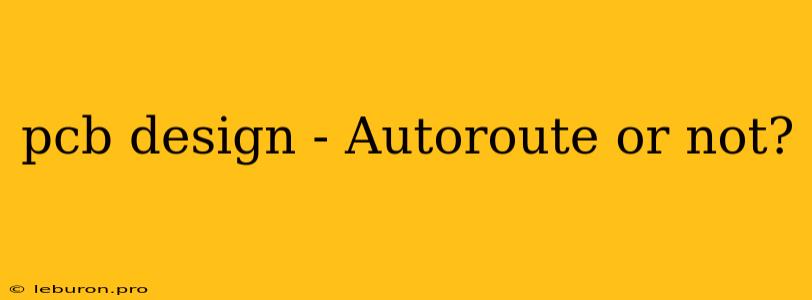The world of PCB design is constantly evolving, with new tools and techniques emerging regularly. One question that frequently arises among designers, especially those starting their journey, is whether to utilize autorouting software like Autoroute or rely on manual routing. While both approaches have their merits, understanding the pros and cons of each can help you choose the best method for your specific project and skill level. In this article, we will delve into the world of PCB design, examining the benefits and drawbacks of using Autoroute and manual routing, providing a comprehensive guide to help you make an informed decision for your next project.
The Power of Autorouting: Streamlining the Design Process
Autorouting software, like the widely known Autoroute, offers a tempting shortcut for PCB designers, promising to automate the often tedious and time-consuming task of routing traces. By leveraging powerful algorithms and sophisticated routing rules, Autoroute can significantly reduce design time, especially for complex boards with numerous components and tight spacing.
Benefits of Using Autoroute:
- Faster Routing: Autoroute can automatically route traces, saving you countless hours of manual effort. This is particularly beneficial for large, complex boards with numerous interconnections.
- Improved Design Consistency: Autorouting software follows predefined rules and constraints, ensuring that all traces meet specific width, spacing, and clearance requirements, contributing to a more consistent and reliable design.
- Easier to Learn: Autoroute's user-friendly interface and automated features make it easier for beginners to learn and use, allowing them to focus on the overall circuit design rather than struggling with manual routing.
- Exploration of Different Routing Solutions: Autoroute can generate multiple routing solutions, allowing you to compare and choose the best option based on factors like trace length, routing density, and overall design aesthetics.
Potential Drawbacks of Autorouting:
- Reduced Control: While Autoroute can save time, it also limits your control over the routing process. You may not be able to achieve the exact layout you envisioned, and the software might make choices you wouldn't have made manually.
- Possible Routing Errors: Autoroute isn't perfect, and it can sometimes generate suboptimal or even erroneous routing solutions. This can lead to design flaws that might not be apparent during initial inspection.
- Limited Flexibility: Autoroute might struggle to accommodate complex routing scenarios or unique design requirements that deviate from the default rules and constraints.
- Need for Optimization: While Autoroute provides a good starting point, it often requires manual tweaking and optimization to ensure the final design meets your specifications and performance expectations.
Manual Routing: Precision and Control in Your Hands
While Autoroute offers convenience and efficiency, some designers prefer the precision and control of manual routing. This approach allows you to take full responsibility for every trace placement, ensuring a design that precisely meets your requirements.
Advantages of Manual Routing:
- Complete Control: You have complete control over every trace placement, allowing you to create a design that meets your specific needs and performance requirements.
- Flexibility and Customization: Manual routing allows you to adapt to complex routing scenarios and design constraints that Autoroute might struggle with, enabling unique and optimized layouts.
- Improved Understanding: Manually routing traces provides a deeper understanding of the PCB design process and the interplay of various components and interconnections.
- Reduced Risk of Errors: By manually placing each trace, you can ensure that they meet specific design requirements, minimizing the risk of routing errors that can occur with Autoroute.
Challenges of Manual Routing:
- Time-Consuming: Manual routing can be time-consuming, especially for large and complex PCBs.
- Requires Expertise: Effective manual routing requires a considerable level of expertise and experience, making it challenging for beginners.
- Potential for Human Error: Manual routing is prone to human error, especially when dealing with intricate routing scenarios or tight spacing requirements.
- Less Consistent: Manual routing can lead to inconsistencies in trace widths, spacing, and clearances if not executed carefully, potentially affecting the overall design quality.
Choosing the Right Approach: A Balancing Act
The decision to use Autoroute or manual routing is not a simple one-size-fits-all solution. The best approach depends on factors such as your project complexity, skill level, available time, and design constraints. Here's a guide to help you make the right decision:
- For Simple Boards: If you're working on a small, simple board with limited components and straightforward routing needs, manual routing might be a more efficient option. You can achieve the desired layout quickly and have full control over every trace.
- For Complex Boards: When dealing with complex boards with numerous components, tight spacing, and intricate routing requirements, Autoroute can be a valuable tool. It can significantly reduce design time, allowing you to focus on other design aspects. However, remember that Autoroute might require manual optimization and fine-tuning to achieve the desired results.
- For Beginners: If you're new to PCB design, Autoroute can be a good starting point. Its user-friendly interface and automated features make it easier to learn the basics of routing. As you gain experience, you can gradually transition to manual routing for more complex projects.
- For Experienced Designers: Experienced designers often prefer manual routing, as it allows for greater control, flexibility, and optimization. They can leverage their expertise to create complex and efficient layouts that meet specific design requirements.
Conclusion
Whether you choose to embrace the speed and automation of Autoroute or the precision and control of manual routing, both methods have their place in the world of PCB design. Ultimately, the key is to choose the approach that best suits your specific project needs and skill level. By understanding the pros and cons of each method, you can make an informed decision that leads to a successful and efficient PCB design process. Remember, both methods require a good understanding of PCB design principles and the ability to critically evaluate the generated results to ensure a high-quality final design. By continually expanding your knowledge and experimenting with different techniques, you can become a more proficient and versatile PCB designer.
